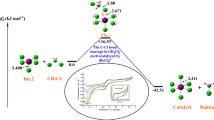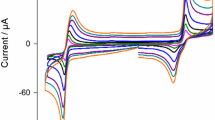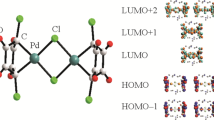Abstract
In tetrahydrofuran, the electrochemical reduction of Cp2TiIVCl2 (2 mM) generated three titanium(III) complexes which were in equilibrium: [Cp2TiCl2]•−, [Cp2TiCl]• and (Cp2TiCl)2. Although the anion radical [Cp2TiCl2]•− was the main species produced under these conditions, cyclic voltammetry investigations clearly showed that the proportion of the three electrogenerated TiIII complexes can be modified as a function of the amounts of chloride ion present in the solution. Accordingly, the presence of Mg2+ ions, which led to the consumption of chloride ions through the formation of MgCl2, favoured the formation of [Cp2TiCl]• and, consequently, of the corresponding dimer (Cp2TiCl)2. The electrochemical behaviours of Cp2TiIVCl2 and of the electrogenerated low-valent Ti complexes were also investigated in the presence of amide and alkyne derivatives. Under these conditions, titanium complexes could not only interact with the amide carbonyl group, but also with the alkyne triple bond, provided the latter was not sterically hindered. Interestingly, the carbonyl group and the triple bond had antagonist effects on redox properties of titanium(III) complexes.





Similar content being viewed by others
REFERENCES
Rosales, A., Rodríguez-García, I., Muñoz-Bascón, J., Roldan-Molina, E., Padial, N.M., Morales, L.P., García-Ocaña, M., and Oltra, J.E., The nugent reagent: a formidable tool in contemporary radical and organometallic chemistry, Eur. J. Org. Chem., 2015, vol. 21, p. 4567.
Gansäuer, A. and Bluhm, H., Reagent-controlled transition-metal-catalyzed radical reactions, Chem. Rev., 2000, vol. 100, p. 2771.
Cuerva, J.M., Justicia, J., Oller-Lopez, J.L., and Oltra, J.E., Cp2TiCl in natural product synthesis, Top. Curr. Chem., 2006, vol. 264, p. 63.
Streuff, J., The electron-way: metal-catalyzed reductive umpolung reactions of saturated and α,β-unsaturated carbonyl derivatives, Synthesis, 2013, vol. 45, p. 281.
RajanBabu, T.V. and Nugent, W.A., Selective generation of free radicals from epoxides using a transition-metal radical. A powerful new tool for organic synthesis, J. Am. Chem. Soc., 1994, vol. 116, p. 986.
Gansäuer, A., Bluhm, H., and Pierobon, M., Emergence of a novel catalytic radical reaction: titanocene-catalyzed reductive opening of epoxides, J. Am. Chem. Soc., 1998, vol. 120, p. 12849.
Gansäuer, A., Novel concept for efficient transition-metal-catalyzed reactions: a highly diastereoselective titanocene-catalyzed pinacol coupling under buffered protic conditions, J. Org. Chem., 1998, vol. 63, p. 2070.
Gansäuer, A. and Bauer, D., A novel concept for transition-metal-catalyzed reactions: electron transfer under buffered protic conditions, Eur. J. Org. Chem., 1998, vol. 11, p. 2673.
Estévez, R.E., Paradas, M., Millán, A., Jiménez, T., Robles, R., Cuerva, J.M., and Oltra, J.E., Ti-catalyzed Reformatsky-type coupling between α-halo ketones and aldehydes, J. Org. Chem., 2008, vol. 73, p. 1616.
Estévez, R.F., Oller-López, J.L., Robles, R., Melgarejo, C.R., Gansäuer, A., Cuerva, J.M., and Oltra, J.E., Stereocontrolled coupling between aldehydes and conjugated alkenals mediated by TiIII/H2O, Org. Lett., 2006, vol. 8, p. 5433.
Streuff, J., A titanium(III)-catalyzed redox umpolung reaction for the reductive cross-coupling of enones with acrylonitriles, Chem. Eur. J., 2011, vol. 17, p. 5507.
Feurer, M., Frey, G., Luu, H.-T., Kratzert, D., and Streuff, J., The cross-selective titanium(III)-catalysed acyloin reaction, Chem. Commun., 2014, vol. 50, p. 5370.
Frey, G., Luu, H.-T., Bichovski, P., Feurer, M., and Streuff, J., Convenient titanium(III)-catalyzed synthesis of cyclic aminoketones and pyrrolidinones-development of a formal [4+1] cycloaddition, Angew. Chem. Int. Ed., 2013, vol. 52, p. 7131; Praktische titan(III)-katalysierte synthese von cyclischen aminoketonen und pyrrolidinonen—entwicklung einer formalen [4+1]-cycloaddition, Angew. Chem., 2013, vol. 125, p. 7271.
Bichovski, P., Haas, T.M., Kellera, M., and Streuff, J., Direct conjugate alkylation of α,β-unsaturated carbonyls by TiIII-catalysed reductive umpolung of simple activated alkenes, Org. Biomol. Chem., 2016, vol. 14, p. 5673.
Zhang, Y. and Liu, T., Cp2TiCl2-catalyzed reaction of Grignard reagents with diaryl ketones, formation of pinacolic coupling from diaryl ketones, Synth. Commun., 1988, vol. 18, p. 2173.
Gansäuer, A., Pierobon, M., and Bluhm, H., Catalytic, highly regio- and chemoselective generation of radicals from epoxides: titanocene dichloride as an electron transfer catalyst in transition metal catalyzed radical reactions, Angew. Chem. Int. Ed., 1998, vol. 37, p. 101; Catalytic, highly regio- and chemoselective generation of radicals from epoxides: titanocenes as electron transfer catalysts in transition metal catalyzed radical reactions, Angew. Chem., 1998, vol. 110, p. 107.
Barrero, A.F., Rosales, A., Cuerva, J.M., and Oltra, J.E., Unified synthesis of eudesmanolides, combining biomimetic strategies with homogeneous catalysis and free-radical chemistry, Org. Lett., 2003, vol. 5, p. 1935.
Fuse, S., Hanochi, M., Doi, T., and Takahashi, T., Ti(III)-catalyzed radical cyclization of 6,7-epoxygeranyl acetate, Tetrahedron Lett., 2004, vol. 45, p. 1961.
Coutts, R.S.P., Wailes, P.C., and Martin, R.L., Novel reactions of monocyclopentadienyltitanium(III) dihalides with organic carbonyl groups, J. Organomet. Chem., 1973, vol. 50, p. 145.
Birmingham, J.M., Fischer, A.K., and Wilkinson, G., The reduction of bis-cyclopentadienyl compounds, Naturwissenschaften, 1955, vol. 42, p. 96.
Sekutowski, D.J. and Stucky, G.D., Synthesis and structure of some bis(cyclopentadienyl)titanium(III) metal halides, Inorg. Chem., 1975, vol. 14, p. 2192.
Samuel, E. and Vedel, J., Electrochemical and chemical reduction of titanocene dihalides—an ESR study, Organometallics, 1989, vol. 8, p. 237.
Enemærke, R.J., Hjøllund, G.H., Daasbjerg, K., and Skrydstrup, T., Is the trinuclear complex the true reducing species in the Cp2TiCl2/Mn- and Cp2TiCl2/Zn-promoted pinacol coupling?, C. R. Acad. Sci. Ser. IIc: Chim., 2001, vol. 4, p. 435.
Enemærke, R.J., Larsen, J., Skrydstrup, T., and Daasbjerg, K., Mechanistic investigation of the electrochemical reduction of Cp2TiX2, Organometallics, 2004, vol. 23, p. 1866.
Enemærke, R.J., Larsen, J., Skrydstrup, T., and Daasbjerg, K., Revelation of the nature of the reducing species in titanocene halide-promoted reductions, J. Am. Chem. Soc., 2004, vol. 126, p. 7853.
Barden, M.C. and Schwartz, J., Stereoselective pinacol coupling in aqueous media, J. Am. Chem. Soc., 1996, vol. 118, p. 5484.
Paradas, M., Campaña, A.G., Estévez, R.E., Álvarez de Cienfuegos, L., Jiménez, T., Robles, R., Cuerva, J.M., and Oltra, J.E., Unexpected TiIII/Mn-promoted pinacol coupling of ketones, J. Org. Chem., 2009, vol. 74, p. 3616.
Labbé, E. and Buriez, O., The fundamental input of analytical electrochemistry in the determination of intermediates and reaction mechanisms in electrosynthetic processes, ChemElectroChem, 2019, vol. 6, p. 4118.
Madelaine, C., Buriez, O., Crousse, B., Florent, I., Grellier, P., Retailleau, P., and Six, Y., Aminocyclopropanes as precursors of endoperoxides with antimalarial activity, Org. Biomol. Chem., 2010, vol. 8, p. 5591.
Kulinkovich, O.G., Sviridov, S.V., Vasilevskii, D.A., and Prityskaya, T.S., Reaction of ethylmagnesium bromide with carboxylic esters in the presence of tetraisopropoxytitanium, Russ. J. Org. Chem., 1989, vol. 25, p. 2027.
Kulinkovich, O.G., Sviridov, S.V., and Vasilevski, D.A., Titanium(IV) isopropoxide-catalyzed formation of 1‑substituted cyclopropanols in the reaction of ethylmagnesium bromide with methyl alkanecarboxylates, Synthesis, 1991, no. 3, p. 234.
Wolan, A. and Six, Y., Synthetic transformations mediated by the combination of titanium(IV) alkoxides and Grignard reagents: selectivity issues and recent applications. Part 1: reactions of carbonyl derivatives and nitriles, Tetrahedron, 2010, vol. 66, p. 15; Wolan, A. and Six, Y., Synthetic transformations mediated by the combination of titanium(IV) alkoxides and Grignard reagents: selectivity issues and recent applications. Part 2: reactions of alkenes, allenes and alkynes, Tetrahedron, 2010, vol. 66, p. 3097; Cha, J.K. and Kulinkovich, O.G., The Kulinkovich cyclopropanation of carboxylic acid derivatives, in Organic Reactions, Denmark, S.E., Ed., John Wiley & Sons, 2012, p. 17; Ebner, C. and Carreira, E.M., Cyclopropanation strategies in recent total syntheses, Chem. Rev., 2017, vol. 117, p. 11651.
Chaplinski, V. and de Meijere, A., A versatile new preparation of cyclopropylamines from acid dialkylamides, Angew. Chem. Int. Ed., 1996, vol. 35, p. 413.
Lee, J. and Cha, J.K., Facile preparation of cyclopropylamines from carboxamides, J. Org. Chem., 1997, vol. 62, p. 1584.
de Meijere, A., Chaplinski, V., Winsel, H., Kordes, M., Stecker, B., Gazizova, V., Savchenko, A. I., Boese, R., and Schill, F. (born Brackmann), Cyclopropylamines from N,N-dialkylcarboxamides and Grignard reagents in the presence of titanium tetraisopropoxide or methyltitanium triisopropoxide, Chem. Eur. J., 2010, vol. 16, p. 13862.
Fischer, M., Vincent-Heldt, L., Hillje, M., Schmidtmann, M., and Beckhaus, R., Synthesis of a titanium ethylene complex via C–H-activation and alternative access to Cp2Ti(η2-Me3SiC2SiMe3), Dalton Trans., 2020, vol. 49, p. 2068; Rosenthal, U., Recent synthetic and catalytic applications of group 4 metallocene bis(trimethylsilyl)acetylene complexes, Eur. J. Inorg. Chem., 2019, no. 7, p. 895; Rosenthal, U., Advantages of group 4 metallocene bis(trimethylsilyl)acetylene complexes as metallocene sources towards other synthetically used systems, Chem. Open, 2019, vol. 8, p. 1036.
Rassadin, V.A. and Six, Y., A study of the reaction of nBuLi with Ti(OiPr)4 as a method to generate titanacyclopropane and titanacyclopropene species, Tetrahedron, 2014, vol. 70, p. 787.
Mizoguchi, H. and Micalizio, G.C., Synthesis of highly functionalized decalins via metallacycle-mediated cross-coupling, J. Am. Chem. Soc., 2015, vol. 137, p. 6624; Mizoguchi, H. and Micalizio, G.C., Synthesis of angularly substituted trans-fused decalins through a metallacycle-mediated annulative cross-coupling cascade, Angew. Chem. Int. Ed., 2016, vol. 55, p. 13099; Kim, W.S., Du, K., Hughes, R.P., and Micalizio, G.C., Synthetic nat- or ent-steroids in as few as five chemical steps from epichlorohydrin, Nature Chem., 2018, vol. 10, p. 70; Shalit, Z.A. and Micalizio, G.C., A highly chemo-, regio-, and stereoselective metallacycle-mediated annulation between a conjugated enyne and an ene-diyne, ARKIVOC, 2018, vol. 4, p. 132.
Funding
This work was supported by the Agence Nationale de la Recherche (grant number: ANR-12-BS07-0013 “ACTIMAC”), the Centre National de la Recherche Scientifique (CNRS), the École Normale Supérieure, École Polytechnique and Sorbonne University.
Author information
Authors and Affiliations
Corresponding author
Ethics declarations
The authors state that they have no conflict of interests.
Rights and permissions
About this article
Cite this article
Abdou K. D. Dimé, Six, Y. & Buriez, O. An Electrochemical Study of Bis(cyclopentadienyl)titanium(IV) Dichloride in the Presence of Magnesium Ions, Amides or Alkynes. Russ J Electrochem 57, 85–91 (2021). https://doi.org/10.1134/S1023193521010031
Received:
Revised:
Accepted:
Published:
Issue Date:
DOI: https://doi.org/10.1134/S1023193521010031




